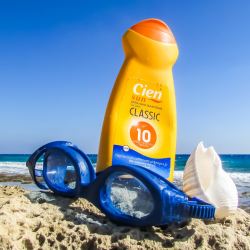When it comes to medications and advertising, the FDA has a host of regulations designed “to better inform us,” helping to separate fact from hype. The evidence for food labels helping nudge better choices is plus-minus. How about preventative care, like sunscreen? A new study shows that labeling regulation is failing.
The researchers looked at labels for sunscreen, an over-the-counter product widely use to protect your skin from the sun – it generates roughly $1.2 billion in sales in 2019 [1]. The FDA wants to require listing the active ingredient on the main panel of the product. Here is the current and proposed re-design.

Rather than make the consumer search for this “vital” safety information, the FDA wants to put it upfront where it can be found. Certainly not an unreasonable idea. But the researchers asked a different question, were the active ingredients helpful information for the consumer in deciding upon a product?
Participants over age 18 were recruited from a consumer panel and interviewed in-person to determine what information on the sunscreen label was most important to them and what information was used in their decision-making. The study was small, with 47 participants, about 42 years old, 68% women, 85% with a bachelor’s degree or better. They were aware of the need for sunscreen as 85% were “sun-sensitive,” and the group had experienced an average of 2 sunburns in the last year.
- What on the label was the most influential in their decision-making? 28% pointed to those active ingredients, but 72% just considered the SPF – the sunscreen protection factor.
- What was the most critical information on the label? Again SPF, at least for a third of the consumers, only 11% thought the active ingredients were the most important.
- Nearly a quarter (21%) of these consumers reported that they usually read the labels to look at the active ingredients, most often over a desire to avoid harmful components. But only 11% could recall any ingredient when looking at both the old and new labels.
Despite the study's size, the data is strongly suggestive that few consumers consider active ingredients in making their sunscreen choice; to be fair, a small percentage do look at the ingredient to “not choose” a product. But overwhelmingly, all we want to know is the SPF, which is already clearly on the front of the product. This is in line with other work cited by the researchers where even SPF played second fiddle to “cosmetic elegance” – “how easily the product rubs in.” When it comes to ingredients, this other panel was looking for “natural or organic,” which we know to be more a reflection of marketing than science.
“It is unclear if listing active ingredients on the principal display panel of the sunscreen label alone will help consumers compare and select sunscreens.”
Few of us look at active ingredients, and even fewer recall them. So why are we expending regulatory energy on them? Does it satisfy a pseudo-scientific need? It makes it seem our regulators care about our health?
This problem is not limited to sunscreen. It is a far more significant and more concerning problem with medications advertised on television. Consider the many advertisements for Skyrizi or Tremfya, two biologics for rheumatoid arthritis. [2] What are the most common adverse effects? I doubt anyone can answer that question after watching the advertisement. These ads are crafted by experts at media and approved by attorneys. If we are going to take regulation of advertising for medicines, prescription, or OTC seriously, then we need to research as to what is important to consumers and how best to get them the information they need. Of course, the most reliable source is always mentioned in the ads – “Talk to your doctor.”
[1] Statistica
[2] They were just two medications that came to mind; there are many, many more.
Source: Perceived Usefulness and Recall of Sunscreen Label Information by Consumers JAMA Dermatology DOI: 10.1001/jamadermatol.2020.5394

